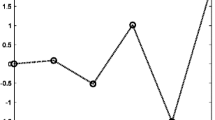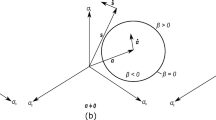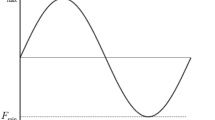Abstract
This work investigates a simplified approach to cope with the optimization of preliminary design of structures under local fatigue constraints along with a global enforcement on the overall compliance. The problem aims at the minimization of the weight of linear elastic structures under given loads and boundary conditions. The expected stiffness of the optimal structure is provided by the global constraint, whereas a set of local stress–based constraints ask for a structure to be fatigue resistant. A modified Goodman fatigue strength comparison is implemented through the same formalism to address pressure–dependent failure in materials as in Drucker–Prager strength criterion. As a simplification, the Sines approach is used to define the equivalent mean and alternating stresses to address the fatigue resistance for an infinite life time. Sines computation is based on the equivalent mean and alternate stress depending on the invariants of the stress tensor and its deviatoric part, respectively. The so–called singularity phenomenon is overcome by the implementation of a suitable qp-relaxation of the equivalent stress measures. Numerical examples are presented to illustrate the features of the achieved optimal layouts and of the proposed algorithm.
















Similar content being viewed by others
Notes
1 \(\mathbf {M}^{0}_{e}= \mathbf {T_{e}^{0,T}}\mathbf {V}\mathbf {{T_{e}^{0}}}\) with \(\mathbf {V}= \left (\begin {array}{ccc} 1 & -1/2 & 0 \\ -1/2 & 1 & 0\\ 0& 0 & 3 \end {array}\right )\).
2 \(\mathbf {H}^{0}_{e}=\left (\begin {array}{l}1\\1\\0 \end {array}\right )\mathbf {{T_{e}^{0}}}\).
References
Bendsœ M, Kikuchi N (1988) Generating optimal topologies in structural design using a homogeneization method. Comp Meth Appl Mech Eng 71:197–224
Bendsœ M, Sigmund O (2003) Topology optimization - Theory, methods and applications. Springer, EUA, New York
Bourdin B (2001) Filters in topology optimization. Int J Numer Methods Eng 50:2143–2158
Bruggi M (2008) On an alternative approach to stress constraints relaxation in topology optimization. Struct Multidiscip Optim 36:125–141
Bruggi M, Dusyinx P (2012) Topology optimization for minimum weight with compliance and stress constraints. Struct Multidisc Optim 46(3):369–384
Bruggi M, Dusyinx P (2013) A stress–based approach to the optimal design of structures with unilateral behavior of material or supports. Struct Multidisc Optim 46(3):369–384
Budynas RG, Nisbett JK (2011) Shigley’s mechanical engineering design, 9th edn. McGraw-Hill, New York
Bruns TE, Tortorelli DA (2001) Topology optimization of non–linear elastic structures and compliant mechanisms. Comp Meth Appl Mech Eng 190:3443–3459
Cheng GD, Guo X (1997) ε–relaxed approach in topology optimization. Struct Optim 13:258–266
Duysinx P, Bendsœ MP (1998) Topology optimization of continuum structures with local stress constraints. Int J Numer Methods Eng 43:1453–1478
Duysinx P, Sigmund O (1998) New developments in handling stress constraints in optimal material distribution. 7th Symposium on Multidisciplinary Analysis and Optimization AIAA–98–4906: 1501–1509
Duysinx P, Van Miegroet L, Lemaire E, Brüls O, Bruyneel M (2008) Topology and generalized shape optimization: why stress constraints are so important? Int J Simul Multidiscip Des Optim 2:253–258
Eschenauer HA, Olhoff N (2001) Topology optimization of continuum structures: a review. Appl Mech Rev 54:331–389
Grunwald J, Schnack E (1997) A fatigue model for shape optimization. Struct Optim 14:36–44
Guilherme CEM, Fonseca JSO (2007) Topology optimization of continuum structures with epsilon-relaxed stress constraints. In: Alves M, Da Costa Mattos HS (eds) Solid mechanics in Brazil, vol 1. ABCM, Rio de Janeiro, pp 239–250
Holmberg E, Torstenfelt B, Klarbring A (2013) Stress constrained topology optimization. Struc Multidisc Optim 48:33–47
Holmberg E, Torstenfelt B, Klarbring A (2014) Fatigue constrained topology optimization. Struc Multidisc Optim 50:207–219
Kaya N, Karen I, Öztürk F (2010) Re-design of a failed clutch fork using topology and shape optimization by the response surface method. Mater Des 31:3008–3014
Kim Y, Park G (2010) Nonlinear dynamic response structural optimization using equivalent static loads. Comput Methods Appl Mech Eng 199:660–676
Kirsch U (1990) On singular topologies in optimal structural design. Struct Optim 2:133–142
Lalanne C (1999) Mechanical vibration & shock. Volume IV, Fatigue damage. Hermes Penton Science 1999.19
Le C, Norato J, Bruns TE, Ha C, Tortorelli DA (2010) Stress–based Topology Optimization for Continua. Struct Multidiscip Optim 41:605–620
Luo Y, Yu Wang Yu M, Kang Z (2013) An enhanced aggregation method for topology optimization with local stress constraints. Comput Method Appl Mech Engrg 254:31–41
Mrzygold M, Zielinski A (2006) Numerical implementation of multiaxial high-cycle fatigue criterion to structural optimization. J Theor Appl Mech 44(3):691–712
Norton R (2000) Machine design: An integrated approach. Prentice Hall, N.J
París J, Navarrina F, Colominas I, Casteleiro M (2009) Topology optimization of continuum structures with local and global stress constraints. Struct Multidisc Optim 39(4):419–437
Park GJ, Kang BS (2003) Validation of a structural optimisation algorithm transforming dynamic loads into equivalent static loads. J Optim Theory Appl 118(1):191–200
Pereira JT, Fancello EA, Barcellos CS (2004) Topology optimization of continuum structures with material failure constraints. Struct Multidisc Optim 26(1–2):50–66
Rozvany GIN (2009) A critical review of established methods of structural topology optimization. Struct Multidiscip Optim 37:217– 237
Seung H, Dong-Hoon C, Yoon G (2015) Fatigue and static failure considerations using topology optimization method. Appl Math Model 39:1137–1162
Sherif K, Irschik H (2010) Efficient topology optimization of large dynamic finite element systems using fatigue. AIAA J 48(7):1339–1347
Schütz W (1996) A history of fatigue. Eng Fract Mech 54(2):263–300
Sigmund O, Petersson J (1998) Numerical instabilities in topology optimization: a survey on procedures dealing with checkerboards, mesh-dependencies and local minima. Struct Optim 16:68–75
Svanberg K (1987) Method of moving asymptotes - a new method for structural optimization. Int J Numer Methods Eng 24:359–373
Svanberg K, Werme M (2007) Sequential integer programming methods for stress constrained topology optimization. Struct Multidisc Optim 34(4):277–299
Svärd H (2015a) Topology optimization of Fatigue-Constrained structures. Doctoral Thesis KTH Engineering Sciences, Stockholm, Sweden
Svärd H (2015b) Interior value extrapolation: a new method for stress, evaluation during topology optimization. Struct Multidisc Optim 51:613–629
Sved G, Ginos Z (1968) Structural optimization under multiple loading. Int J Mech Sci 10:803–805
Yang RJ, Chen CJ (1996) Stress-based topology optimization. Struct Multidisc Optim 12(2):98–105
Weibull W (1939) Statistical theory of the strength of materials. Ingeniörsvetenskapsakademiens handlingar Generalstabens litografiska anstalts förlag
Acknowledgments
Part of the work has been done when the first author was spending a research period at Politecnico di Milano. This author would like to acknowledge the Belgian National Fund for Scientific research (FRIA) for its financial support.
Author information
Authors and Affiliations
Corresponding author
Rights and permissions
About this article
Cite this article
Collet, M., Bruggi, M. & Duysinx, P. Topology optimization for minimum weight with compliance and simplified nominal stress constraints for fatigue resistance. Struct Multidisc Optim 55, 839–855 (2017). https://doi.org/10.1007/s00158-016-1510-6
Received:
Revised:
Accepted:
Published:
Issue Date:
DOI: https://doi.org/10.1007/s00158-016-1510-6




